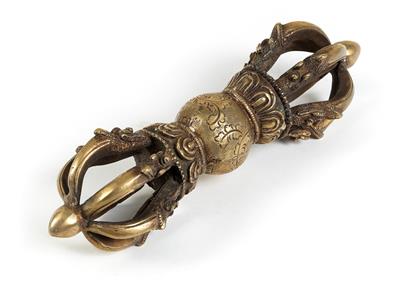Tibet, Nepal: a ‘dorje’ or ‘vajra’ cult object, also known as a diamond sceptre, for sacred rituals in Lamaistic Buddhism.
Tibet, Nepal: a ‘dorje’ or ‘vajra’ cult object, also known as a diamond sceptre, for sacred rituals in Lamaistic Buddhism.

In Tibetan Buddhism all monks (‘Lamas’) hold a small ‘dorje’ in their right, ‘male’ hand during their daily ceremonies, and a bell on a handle (‘ghanta’) in their left, ‘female’ hand. Dorjes are also often held by cast statues of sacred gods. In larger sizes, up to several metres tall, dorjes are also positioned in front of temples or on altars as independent cult objects to be worshipped.
The present dorje is an independent sacred object of this type, designed to be placed on an altar for worship. It is probably too large and heavy for a monk to use on a daily basis. It is made of yellow cast-alloy (brass) using the waste mould method. The ‘handle’ in the middle is dome-shaped, and engraved with leafy tendrils and dotted surfaces. Six dragon heads protrude from lotus flowers to the left and to the right (as a fortune symbol). Six curved spokes or claws protrude from each of their mouths, ending on both sides in two lotus buds. These spokes or claws symbolise the possible ways a person can reach Nirvana, the final stage of happiness, peace and enlightenment.
Length: 23.5 cm; weight: c. 1000 g. First half to mid-20th century. (ME)
Esperto: Prof. Erwin Melchardt
 Prof. Erwin Melchardt
Prof. Erwin Melchardt
+43-1-515 60-465
erwin.melchardt@dorotheum.at
06.04.2017 - 15:00
- Prezzo realizzato: **
-
EUR 500,-
- Prezzo di partenza:
-
EUR 400,-
Tibet, Nepal: a ‘dorje’ or ‘vajra’ cult object, also known as a diamond sceptre, for sacred rituals in Lamaistic Buddhism.
In Tibetan Buddhism all monks (‘Lamas’) hold a small ‘dorje’ in their right, ‘male’ hand during their daily ceremonies, and a bell on a handle (‘ghanta’) in their left, ‘female’ hand. Dorjes are also often held by cast statues of sacred gods. In larger sizes, up to several metres tall, dorjes are also positioned in front of temples or on altars as independent cult objects to be worshipped.
The present dorje is an independent sacred object of this type, designed to be placed on an altar for worship. It is probably too large and heavy for a monk to use on a daily basis. It is made of yellow cast-alloy (brass) using the waste mould method. The ‘handle’ in the middle is dome-shaped, and engraved with leafy tendrils and dotted surfaces. Six dragon heads protrude from lotus flowers to the left and to the right (as a fortune symbol). Six curved spokes or claws protrude from each of their mouths, ending on both sides in two lotus buds. These spokes or claws symbolise the possible ways a person can reach Nirvana, the final stage of happiness, peace and enlightenment.
Length: 23.5 cm; weight: c. 1000 g. First half to mid-20th century. (ME)
Esperto: Prof. Erwin Melchardt
 Prof. Erwin Melchardt
Prof. Erwin Melchardt
+43-1-515 60-465
erwin.melchardt@dorotheum.at
|
Hotline dell'acquirente
lun-ven: 10.00 - 17.00
kundendienst@dorotheum.at +43 1 515 60 200 |
| Asta: | Tribal Art |
| Tipo d'asta: | Asta in sala |
| Data: | 06.04.2017 - 15:00 |
| Luogo dell'asta: | Wien | Palais Dorotheum |
| Esposizione: | 01.04. - 06.04.2017 |
** Prezzo d'acquisto comprensivo di tassa di vendita e IVA
Non è più possibile effettuare un ordine di acquisto su Internet. L'asta è in preparazione o è già stata eseguita.
